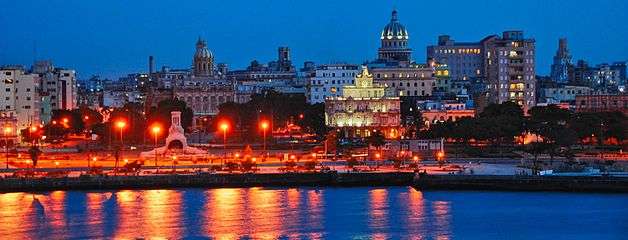Hispanic America
.svg.png)
.svg.png)
|
|
|
|

Hispanic America or Spanish America (Spanish: Hispanoamérica, América española or América hispana) is the region comprising the Spanish-speaking nations in the Americas.[1][2]
These countries have significant commonalities with each other and with Spain, its former European metropolis. In all of these countries, Spanish is the main language, sometimes sharing official status with one or more indigenous languages (such as Guaraní, Quechua, Aymara, or Mayan), or English (in Puerto Rico).[3] Roman Catholicism is the predominant religion.[4]
Hispanic America differs from Ibero-America in that the latter comprises Hispanic America and Brazil (formerly "Portuguese America"), and for some uses includes the Iberian Peninsula nations of Portugal, Spain and Andorra. Hispanic America also contrasts with Latin America, which includes Hispanic America, Brazil, and also the former French colonies in the Western Hemisphere except (at least) areas that are now in either the United States or Canada.[5]
History
The Spanish conquest of the Americas began in 1492, and ultimately was part of a larger historical process of world discovery, through which various European powers incorporated a considerable amount of territory and peoples in the Americas, Asia, and Africa between the 15th and 20th centuries. Hispanic America became the main part of the vast Spanish Empire.
Napoleon's takeover of Spain in 1808 and the consequent chaos initiated the dismemberment of the Spanish Empire, as the Hispanic American territories began their struggle for emancipation. By 1830, the only remaining Spanish American and Asian territories were Philippine archipelago and the islands of Cuba and Puerto Rico, until the 1898 Spanish–American War.
Countries
| Country | Population | Area[lower-alpha 1] | GDP (nominal)[lower-alpha 2] | GDP (nominal) per capita[6][7] | GDP (PPP) | GDP(PPP) per capita |
|---|---|---|---|---|---|---|
| |
41,214,000 | 2,780,400 | $475.00 | $22,459 | $964 | $22,500 |
| |
10,227,299 | 1,098,581 | $27.43 | $3,030 | $70 | $5,400 |
| |
17,094,275 | 756,950 | $268.20 | $15,775 | $409 | $22,500 |
| |
48,873,936 | 1,141,748 | $427.13 | $8,858 | $640 | $13,400 |
| |
4,579,000 | 51,000 | $45.13 | $10,893 | $71 | $15,000 |
| |
11,451,652 | 110,861 | $72.30 | $6,051 | $121 | $10,200 |
| |
10,090,000 | 48,730 | $59.00 | $13,012 | $106 | $10,060 |
| |
14,067,000 | 256,370 | $80.93 | $5,968 | ||
| |
7,185,000 | 21,040 | $23.82 | $3,875 | ||
| |
14,655,189 | 108,890 | $49.88 | $3,512 | ||
| |
7,793,000 | 112,492 | $18.39 | $2,323 | ||
| |
113,724,226 | 1,972,550 | $1,177.00 | $10,629 | ||
| |
5,743,000 | 129,494 | $10.51 | $2,006 | ||
| |
3,450,349 | 75,571 | $36.25 | $12,744 | ||
| |
6,996,245 | 406,752 | $26.00 | $4,169 | ||
| |
29,885,340 | 1,285,220 | $217.60 | $6,819 | ||
| |
3,994,259 | 9,104 | $93.52 | $27,678 | ||
| |
3,415,920 | 176,215 | $49.40 | $16,609 | ||
| |
28,549,745 | 916,445 | $205.70 | $6,756 | ||
| Total | 376,607,614 | 11,466,903 | $3,460.16 | $9,188 |
Largest cities
| City | Country | Population | Metro |
|---|---|---|---|
| Mexico City | 8,851,080 | 20,137,152 | |
| Buenos Aires' | 3,050,728 | 13,941,973 | |
| Bogotá | 8,854,722 | 13,864,952 | |
| Lima | 7,605,742 | 9,367,587 | |
| Santiago | 5,428,590 | 7,200,000 | |
| Guadalajara | 1,564,514 | 4,328,584 | |
| Caracas | 3,273,863 | 5,289,364 | |
| Monterrey | 1,133,814 | 4,080,329 | |
| Medellín | 2,636,101 | 3,731,447 | |
| Guayaquil | 2,432,233 | 3,328,534 | |
| Santo Domingo | 1,111,838 | 3,310,171[9] | |
| Havana | 2,350,000 | 3,073,000 | |
| Guatemala City | 2,149,107 | 4,703,865 | |
| Maracaibo | 2,201,727 | 2,928,043 | |
| Cali | 2,068,386 | 2,530,796 | |
| San Juan | 434,374 | 2,509,007 | |
| Puebla | 1,399,519 | 2,109,049 | |
| Asunción | 680,250 | 2,089,651 | |
| Montevideo | 1,325,968 | 1,868,335 | |
| Quito | 1,397,698 | 1,842,201 | |
| Managua | 1,380,300 | 1,825,000 | |
| Barranquilla | 1,148,506 | 1,798,143 | |
| Santa Cruz | 1,594,926 | 1,774,998 | |
| Valencia | 894,204 | 1,770,000 | |
| Tegucigalpa | 1,230,000 | 1,600,000 | |
| La Paz | 872,480 | 1,590,000 | |
| San Salvador | 540,090 | 2,223,092 | |
| Tijuana | 1,286,187 | 1,553,000 | |
| Toluca | 467,712 | 1,531,000 | |
| Mérida | 781,146 | 1,035,238 | |
| Barquisimeto | 1,116,000 | 1,500,000 | |
| León | 1,278,087 | 1,488,000 | |
| Córdoba | 1,309,536 | 1,452,000 | |
| Juárez | 1,301,452 | 1,343,000 | |
| Tegucigalpa | 1,250,000 | 1,300,000 | |
| Maracay | 1,007,000 | 1,300,000 | |
| San José | 386,799 | 1,284,000 | |
| Rosario | 908,163 | 1,203,000 | |
| Panama City | 990,641 | 1,500,000 | |
| Torreón | 548,723 | 1,144,000 | |
| Bucaramanga | 516,512 | 1,055,331 |
Flag

While relatively unknown, there is a flag representing the countries of Hispanic America, its people, history and shared cultural legacy.
It was created in October 1933 by Ángel Camblor, captain of the Uruguayan army. It was adopted by all the states of Spanish America during the Pan-American Conference of the same year in Montevideo, Uruguay.[10]
The white background stands for peace, the Inti sun god of Inca mythology symbolizes the light shining on the Americas, and the three crosses represent Christopher Columbus' caravels, the Niña, Pinta, and Santa María, used in his first voyage from Spain to the New World in 1492. The deep lilac color of the crosses evokes the color of the lion on the coat of arms of the medieval Crown of Castile.[11]
Gallery
See also
Notes
References
- ↑ All of the following dictionaries only list "Spanish America" as the name for this cultural region. None list "Hispanic America." All list the demonym for the people of the region discussed in this article as the sole definition, or one of the definitions, for "Spanish American". Some list "Hispanic," "Hispanic American" and "Hispano-American" as synonyms for "Spanish American." (All also include as a secondary definition for these last three terms, persons residing in the United States of Hispanic ancestry.) The American Heritage Dictionary of the English Language (3rd ed.) (1992). Boston: Houghton Mifflin. ISBN 0-395-44895-6. Merriam-Webster's Collegiate Dictionary (11th ed.) (2003). Springfield: Merriam-Webster. ISBN 0-87779-807-9. The Random House Dictionary of the English Language (2nd ed.) (1987). New York: Random House. ISBN 0-394-50050-4. Shorter Oxford English Dictionary on Historical Principles (2007). New York: Oxford University Press. ISBN 978-0-19-920687-2. Webster's New Dictionary and Thesaurus (2002). Cleveland: Wiley Publishing. ISBN 978-0-471-79932-0
- ↑ "Hispanic America" is used in some older works such as Charles Edward Chapman's 1933 Colonial Hispanic America: A History and 1937 Republican Hispanic America: A History (both New York: The Macmillan Co.); or translated titles that faithfully reproduce Hispanoamérica, such as Edmund Stephen Urbanski (1978), Hispanic America and its Civilization: Spanish Americans and Anglo-Americans, Norman: University of Oklahoma Press.
- ↑ "CIA – The World Factbook – Field Listing – Languages". Retrieved 2009-04-11.
- ↑ "CIA – The World Factbook – Field Listing – Religions". Retrieved 2009-04-11.
- ↑ "Latin America" The Free Online Dictionary (American Heritage Dictionary of the English Language, 2000, 4th ed. Houghton Mifflin Company. Updated in 2003.)
- ↑ Data mostly refers to IMF staff estimates for the year 2013, made in April 2014. World Economic Outlook Database-April 2014, International Monetary Fund. Accessed on 9 April 2014.
- ↑ Data refers mostly to the year 2012. World Development Indicators database, World Bank. Database updated on 18 December 2013. Accessed on 18 December 2013.
- ↑ "Demografia de Chile" (PDF). Archived from the original (PDF) on January 27, 2009.
- ↑ "República Dominicana; Población estimada y proyectada por año y sexo, según región, provincia y municipio. 2000-2010" (in Spanish). Oficina Nacional de Estadística (ONE). Retrieved 2010-04-13. Context page: ("Poblacion estimada y proyectada región provincia y municipio 2000-2010.xls")
- 1 2 Raeside, Rob (ed.) (1999-10-11). "Flag of the Race". Flags of the World. Retrieved 2006-12-23.
- ↑ Image of the standard of the Crown of Castile
| ||||||||||












.jpg)

